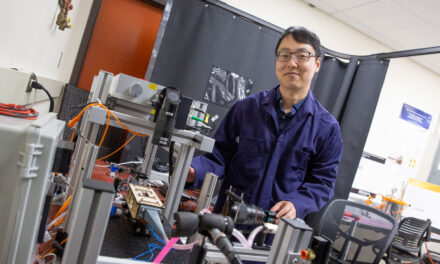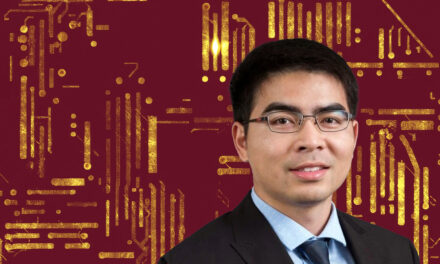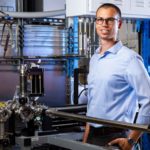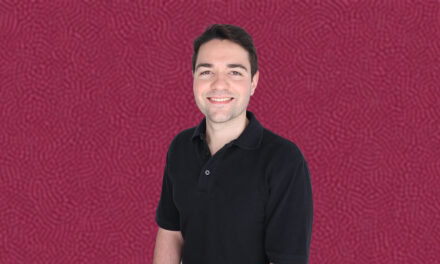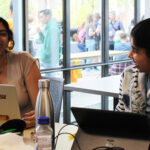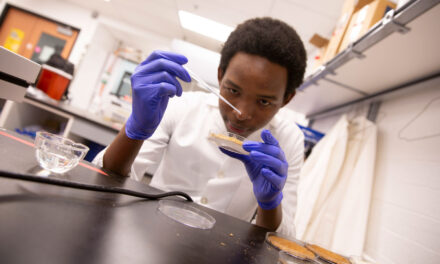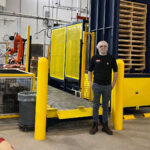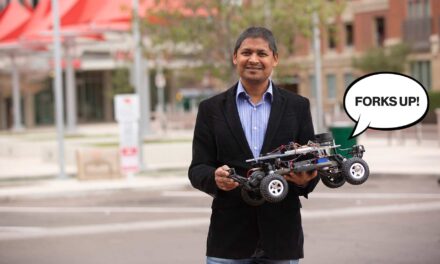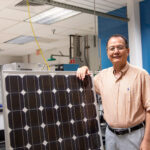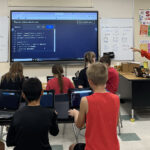
Engineering major starts first year ahead of the game in research prowess
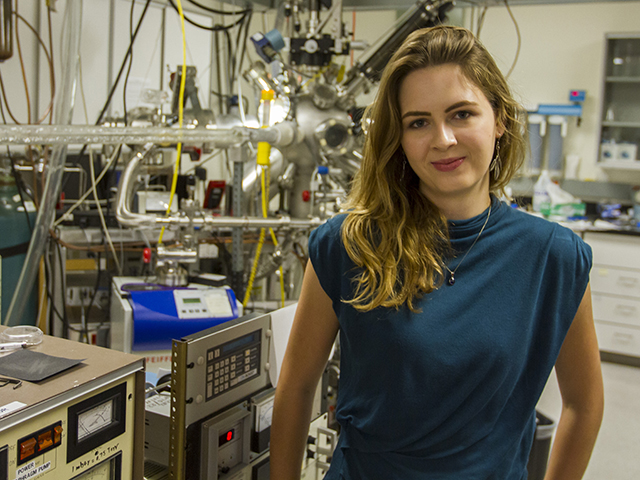
Sarah Galvin, a first-year Arizona State University student, got her start in research as a high school student, working with ASU engineering professor Nathan Newman on developing next-generation electronics through her involvement with ASU’s Southwest Center for Education and the Natural Environment (SCENE). Photographer: Jessica Hochreiter/ASU.
Sarah Galvin’s biggest challenge during the undergraduate career she began at Arizona State University this semester might be matching the impressive accomplishments of her high school years.
Before graduating last spring from Corona del Sol High School in Tempe, Galvin won a first-place prize at the Intel International Science and Engineering Fair, competing against 1,700 of the top high school students from 70 countries.
She had earned her way into the Intel competition by winning the Grand Award at the Arizona Science and Engineering Fair. Before that, she had won first-place and third-place awards in separate Arizona Junior Science and Humanities Symposium competitions.
Reaping rewards
Galvin’s Intel Fair prize for winning first place in the electrical and mechanical engineering category brought with it two scholarships that provide a total of $8,000 to support her studies and the Dudley R. Herschbach Award, which enables her to join some of the world’s most promising young science students in December at the Stockholm International Youth Science Seminar in Sweden. The seminar activities include attending the prestigious Nobel Prize ceremonies in Stockholm.
Her Intel Fair entry was also selected as the best project in computer engineering, earning the K. Soumyanath Memorial Award, which provides a $3,000 scholarship.
The same project has garnered a Future Innovators of the Year Award, one of the annual Arizona Governor’s Celebration of Innovation awards to be presented in November. The awards program organized by the Arizona Technology Council and the Arizona Commerce Authority recognizes technology leaders throughout the state.
Putting interests into action
Galvin’s path to these achievements began in kindergarten, where “someone told me that scientists get to blow things up,” she said. “So then I knew exactly what I wanted to be.”
Later her goal became more focused, when someone told her chemists in particular get to blow things up.
In high school she excelled in chemistry — and every other subject — and didn’t want to wait until going to college to start putting her interests in science into action.
Her chemistry teacher informed her about the Southwest Center for Education and the Natural Environment (SCENE) at ASU, which gives high school students opportunities for research experiences.
Intrigued by electronics
She checked the SCENE program’s offerings at the time and found no chemistry projects. But she was intrigued by the description of work led by Nathan Newman, a professor in the School for Engineering of Matter, Transport and Energy, one of ASU’s Ira A. Fulton Schools of Engineering.
One of Newman’s projects involved his lab team’s efforts to help make the technological breakthroughs necessary to develop next-generation electronics. It involved applying quantum mechanics, manipulating electrons, combining existing materials and creating new ones to make new energy devices, and something called spintronics – short for spin transport electronics – all of which attracted Galvin.
For two years as she finished high school, Galvin spent what time she could in Newman’s lab. She experimented with combining various materials to fashion small structures called tunnel junctions that are capable of using magnetism rather than an electrical current to power devices — a method promising to enable development of electronic devices that would be more compact and energy efficient, and would operate more rapidly.
Mastering Spintronics
The technology is based on taking advantage of the spin of electrons, which creates magnetism.
“When a material has a propensity of electrons with spin in one direction over that of another direction, then the material is magnetic,” Newman explained. “Sarah’s project focused on making materials that can inject electrons from such magnets with only one direction of spin, which produces 100 per cent spin polarization, or as close to that as possible. She has been able to show that enhanced spin polarization can be achieved in the material that is deposited in the process, using less expensive methods than what have been used before.”
The technology promises not only higher-performing consumer electronics, Newman said, but also new devices that could significantly improve the energy efficiency of the kind of advanced supercomputers used by the likes of Google, Yahoo and the National Security Agency.
Galvin’s work in Newman’s lab became the basis for the project she entered in the Intel Fair (called “An Innovative Approach to Improve Spin Polarization in Co2FeAl0.5Si0.5 Thin Films for Spin Transport Electronics”).
Showing leadership in the lab
Her success has helped to secure a position as an undergraduate research associate in Newman’s lab, giving her the opportunity to continue pursuing advances in spintronics.
For the immediate future, her work will be concentrated on producing inexpensive, large-area photovoltaic technology that can be used on building exteriors to generate solar energy, Newman said.
He has little doubt that she will make progress in the effort.
“Most younger students will typically do a small part of the work on projects like this, and then turn things over to an experienced graduate student,” Newman said. “But with some guidance, Sarah has handled most of it herself, including the physics, the engineering and the application of scientific method.”
Driven to make a difference
Galvin has shared authorship credits with Newman and other members of his research team on a paper published in the prominent research journal Applied Physics Letters, a publication of the American Physics Institute.
Her work with Newman’s lab drove her decision to major in electrical engineering, a degree program in the School of Electrical, Computer and Energy Engineering.
“I decided on engineering because I like being able to physically do things and create something,” she said. “I like the mechanics of it, as opposed to some areas of science where you mostly observe and study things. In engineering I can see where I might be able to do something that makes a difference, and so much is happening in electrical engineering right now.”
Exploring myriad opportunities
Even with a full schedule of classes and plans to spend a good portion of time in the laboratory, Galvin has other ambitions for her undergrad years. “I want to explore many different paths,” she said.
She is interested in government and political philosophy, and may consider a double major or a minor in political science or international studies.
As a student in ASU’s Barrett, The Honors College, she plans to take advantage of the opportunities the college offers for studies in other countries.
She also plans to spend school break periods traveling with family and friends, and to keep up with other pursuits — competitive tennis, some archery, a little cooking and a lot of reading.
“I will spend a lot my time in the lab, but not all of it,” Galvin said. “I want to be a well-rounded person.”
Galvin and Newman were interviewed about their research on the KAET-Channel 8 public affairs program Horizon. Watch the video
Her story was also featured by Channel 12 News in Phoenix. Watch the video
Media Contact
Joe Kullman, [email protected]
480-965-8122
Ira A. Fulton Schools of Engineering


